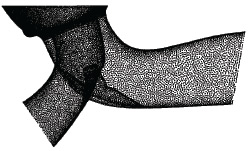Reproducing the Shape of Speed
Wegner Automotive and ADC use Geomagic technology to rev up horsepower for top racing teams.
Latest News
November 2, 2007
By Bob Cramblitt
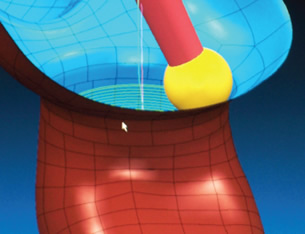 Milling simulation of a cylinder head port in Delcam PowerMill. Digitally reconstructed models ofcylinder head ports were created using Geomagic Studio software. Milling simulation of a cylinder head port in Delcam PowerMill. Digitally reconstructed models ofcylinder head ports were created using Geomagic Studio software. |
Although Carl Wegner was an expert at hand porting, it took him a day to complete a cylinder head, and several days to finish an entire set for an eight-cylinder engine.
Fast-forward 30 years: The name Wegner has become synonymous with engine performance throughout NorthAmerica, and the Markesan, WI-based company is working with Advanced Design Concepts (ADC) to recreate high-performance, hand-ground cylinder ports faster and more accurately than ever before.
The new method pioneered by Wegner and ADC is made possible by digital shape sampling and processing (DSSP), used by major automakers, aerospace companies, and product manufacturers to seamlessly unite physical and digital worlds. The centerpiece of the process is Geomagic Studio software from Geomagic that processes scan data from both a GOM ATOS white-light scanner and a Romer Cimcore arm outfitted with a Perceptron scanner, then digitally reconstructs and duplicates a hand-ground cylinder port for automated manufacturing.
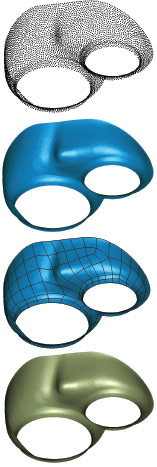 | These models illustrate the scanning series of a combustion bowl. From top: a point cloud is first imported, then polygons are created in Geomagic Studio software, patches are made to fill in gaps and holes, finally surfaces are laid on.This series of images demonstrates how Wegner Automotive reconstructs a preferred combustion bowl. Later, the NURBS surface file is processed by Delcam PowerMill software to specify milling tools and toolpaths, check for clearances, and program five-axis machining. The resulting CAM file is sent for milling on aBostomatic 505 machine. |
The heart of the engine
Like its process for cylinder head porting, Wegner Automotive Research has come a long way during the last three decades. Carl Wegner started his machine shop in a shed in the backyard of a 350-acre farm in central Wisconsin. He worked on everything from local hot rods to pickup trucks to farm tractors. Carl did good work, and his reputation grew quickly, especially in motor sports. It didn’t take long for the farm to give way to the engine shop.
These days, engines from Wegner Automotive compete — and win — in almost every form of American motor sport, from NASCAR to Busch Grand National to various forms of go-cart, motorcycle, and truck racing on asphalt and dirt.
A central part of Wegner Automotive’s success is the ability to use cylinder head porting to coax additional horsepower out of an engine.
“Cylinder head ports make the biggest difference in engine performance,” says Casey Wegner. “They will make or break you. If the horsepower of an engine is less than expected, the head design is the first thing looked at.”
Cylinder head ports allow air and fuel to travel to the cylinders. During the porting process, technicians reshape the ports to remove factory flaws, increase the volume and velocity of air moving to (and away from) the engine, and alter how the air and fuel mixes to create more combustion.
Wegner estimates that his company produces more than 30 types of cylinder heads, which vary according to factors such as the type of vehicle and engine, racetrack characteristics, and rules of the sanctioning organization.
Duplicating the art
The first step in reworking a cylinder head port hasn’t changed appreciably in the last half century. That’s the hand grinding by an expert, a process that combines individual experience, craftsmanship, attention to detail, and some innate wizardry.
Through the years, pros such as Carl Wegner have made an art out of hand-grinding cylinder heads. But, the art is part of the problem. An eight-cylinder engine has eight ports. Once the expert has created an ideal port, it has to be replicated seven times.
Imagine Rodin completing a sculpture and his patron saying, “That’s great Auguste, now do seven more exactly like it.” While that comparison might seem farfetched, it was actually reasier to duplicate Rodin’s work, since molds were typically made from his originals. That can’t be done with cylinder heads, since the sculpting is on the inside of the cylinder head.
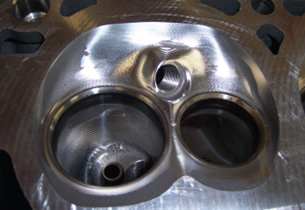 The completed porting of a combustion bowl by Wegner Automotive Researchdemonstrates the ability to digitally reconstruct fine details with Geomagic Studio software. |
Wegner Automotive first attempted to duplicate hand-ground cylinder ports with a CMM system. Key points were collected with a hand probe and point data was loaded into specialized surfacing software.
Although the new process was an improvement over hand-duplication, speed and repeatability were still problems. The probe captured points one at a time about an eighth or sixteenth of an inch apart. Faced with limited data points, the surfacing software could generate only approximate surfaces.
Looking to further improve its processes and gain a greater competitive advantage, Wegner Automotive turned to ADC, based in nearby Pewaukee, WI. ADC had earned a reputation for its ability to reverse-engineer complex, free-form parts for customers such as Harley-Davidson, Richard Childress Racing, Briggs & Stratton, American Blimp, and the Cleveland Clinic. The company’s work has spanned everything from cylinder ports to artificial heart valves.
From days to hours
ADC’s initial scanning process for Wegner Automotive relied on a Perceptron laser scanner mounted to a Romer seven-axis arm. In this process, the cylinder head is sprayed with a talc to reduce reflective surfaces and mounted on a table so that all angles of the port can be captured. The scanning captures a master set of ports, which includes an intake, exhaust, and combustion bowl. Once the master set is scanned, the scanner head is replaced with a hard probe, enabling ADC to capture machined surfaces, valve guides, and dowel-pin locations that are essential for placing the model within a coordinate system.
Scan files for the master set are brought into Geomagic Studio, which aligns and registers the different scans. Patented Geomagic technology “wraps” a polygon surface around the pointcloud model, and the resulting polygon model is edited to fill holes from the scanning, repair scanning “noise,” and define surface attributes.
| 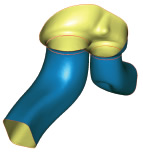 Intake, exhaust, and combustion bowl assembly polygons werecreated digitally from the pointcloud by Geomagic Studio software. |
The polygon model is then automatically converted to a NURBS surface model and duplicated using Geomagic’s mirroring functionality. The mirrored model is placed the proper distance away from the original model along a model of the cylinder head, and the set of two ports are duplicated as many times as needed. In the case of a NASCAR V8 engine, the pair of ports would be duplicated four times.
“Geomagic allows us to quickly import large data sets, filter them to reduce point count, and quickly generate the smooth surfaces that are crucial for maximum efficiency and horsepower,” says Greg Groth, senior designer at ADC. “The hole-filling capability is especially useful for correcting any rough areas from the manual grinding and machining marks.”The combined Perceptron-Geomagic process improved accuracy and enabled ADC to reduce the scanning and processing time from three days to a matter of hours.
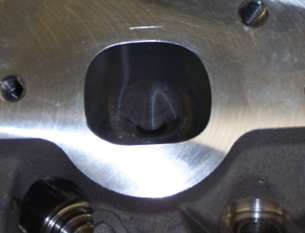 Completed porting of a cylinder head exhaust by Wegner Automotive Research using digital shapesampling and processing (DSSP) technology |
Making the next leap
Although Wegner and ADC have made amazing progress over the last few years, both companies think that the best is yet to come, and this time the implications could extend well beyond cylinder head ports.
ADC recently implemented what Groth calls “hybrid scanning.” ADC uses a GOM ATOS white-light scanner to capture the overall shape and the “hard points” (datums, holes, and other features) of the cylinder head, and the Romer Cimcore scan arm outfitted with a Perceptron scanner to capture hard-to-reach places. The new noncontact, non-destructive process eliminates the painstaking point-by-point collection with a hand probe.
“Nobody thought this could be done,” says Groth. “Using a scanner instead of a manual probe inside the port has reduced data capture time while increasing accuracy and repeatability.”
The process within Geomagic Studio is similar, except that the data sets are larger — around four million points. Decimation features are used to reduce data size without affecting quality. Where GOM and Perceptron data overlap, Geomagic Studio makes it easy to discern and select the best representation.
Wegner Automotive takes the Geomagic NURBS surface file and brings it into Delcam PowerMill software, which has the ability to process multi-patch surfaces. Within PowerMill, Wegner engineers specify tools and toolpaths, check for clearances, and program five-axis machining. The resulting CAM file is sent for milling on a Bostomatic 505 machine.
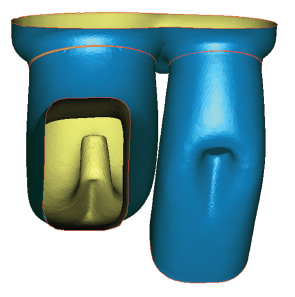 This scan of a cylinder head port shows internal detail that is possible using Geomagic software. |
After machining on the Bostomatic, further cutting is done to correct valve angles, and then airflow is tested on a flow bench and volume is measured to make sure it matches the master. Within a couple of days, an entire set of cylinder head ports can be recreated from an original, machined, tested, and installed into an engine.
“The process is made possible by the ability to scan inside a port and automatically surface it with high accuracy,” says Casey Wegner. “The areas that the scanner cannot ‘see’ are always filled in accurately by Geomagic Studio. People within the racing industry can’t believe how smooth our cylinder ports are.”
The ability to turn out a complete set of cylinder head ports that duplicate a hand-ground original is making a major difference in Wegner Automotive’s business, according to Wegner.
“Porting is what keeps us the busiest,” Wegner says. “Now we can do something nobody has ever been able to do before: We can have a cylinder head handed to us in the middle of the week, prepare a complete duplicate set, and install it in an engine that is ready for a race team by the weekend.”
A Bright Future
Casey Wegner sees a bright future for digital shape sampling and processing within his company’s operations and the automotive performance business in general. Wegner Automotive is already experimenting with manifold porting, which presents many of the same challenges as cylinder head porting. Beyond that, possibilities include using Geomagic surface models to lighten cylinder heads or engine blocks, and digitally recreating the inside of the car and body parts to maximize aerodynamics.
Whatever direction this technology takes, the one common denominator for Wegner Automotive will be performance, whether on the street, the oval, cross-country, or on the drag strip.
More Information
Advanced Design Concepts
Pewaukee, WI
adcinc1.com
Delcam
Birmingham, UK
delcam.com
Geomagic
Research Triangle Park, NC
geomagic.com
GOM
Braunschweig, Germany
gom.com
Mikron Bostomatic
Milford, MA
mikron-ac.com
Perceptron
Plymouth, MI
perceptron.com
Romer
Montoire, France
romer.com
Wegner Automotive Research
Markesan, WI
wegnerautomotive2.com
Bob Cramblitt owns Cramblitt & Company (cramco.com) in Cary, NC, and writes about design, engineering, and IT technologies. Send e-mail about this article to DE-Editorsmailto:[email protected].
Subscribe to our FREE magazine, FREE email newsletters or both!
Latest News
About the Author
DE’s editors contribute news and new product announcements to Digital Engineering.
Press releases may be sent to them via [email protected].







